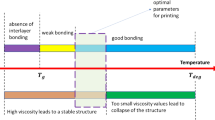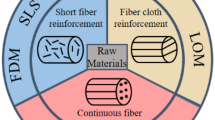Results are given for quantitative evaluation of the adhesive strength of a coating formed by deformation cladding with a flexible tool. It is established that ultimate strength with normal separation of a specimen from an antifriction material coating formed on a steel 45 (HRC 43–45) surface reaches 7.8 MPa on average. Failure is predominantly adhesive in nature.






Similar content being viewed by others
References
V. V. Urtsev, S. I. Platov, V. P. Antsupov, et al., Patent 2224822 RF, IPC7 C 23 C26/00, B21 B27/00, “Method for treating rolling rolls,” Byull., No. 6 (2004).
S. I. Platov, V. P. Antsupov, and D. V. Terent’ev, “Increasing mechanical equipment and production tool component endurance by friction cladding,” Ural. Prom., No. 1, 12–15 (2015).
V. I. Kadoshnikov, S. I. Platov, V. P. Antsupov, et al., “Increase in reliability and endurance of chemical equipment by cladding with a flexible tool,” Uproch. Tekhnol. Pokryt., No. 7, 31–33 (2007).
M. A. Levantsevich and N. M. Maksimchenko, “Improvement of operating properties of components by surface modification of cladding with a flexible tool,” Uproch. Tekhnol. Pokryt., No. 10, 15–20 (2015).
R. R. Dema, Extension of the Life of Metalware Replaceable Equipment Based on Modeling Wear and Using Cladding of Working Surface: Auth. Abstr. Diss. Cand. Techn. Sci., Magnitogorsk State Techn. Univ, Magnitogorsk (2005).
O. M. Smirnov and S. A. Tulupov, “Thermokinetic analysis of friction cladding,” Kuzn. Stamp. Proizv. Obrab. Mater. Davl., No. 9, 38–43 (2009).
M. A. Levantsevich, “Model of contact reaction of a rotating brush bristle with a surface during deformation cladding,” Mekhan. Mashin. Mekhanizm. Mater., No. 2, 74–80 (2014).
V. I. Kadoshnikov, V. P. Antsupov, R. R. Dema, et al., “Expansion of the production potential of cladding with a flexible tool,” Vestn. Mashinostr., No. 10, 64–66 (2003).
S. I. Platov, R. R. Dema, and A. V. Zotov, “Model of forming cladding layer thickness on friction pair components of production equipment,” Vestn. Magnitogorsk Gos. Techn. Univ., No. 1(41). 69–72 (2014).
N. N. Maksimchenko, “Study of friction cladding with a flexible tool using uncompensated second order plans,” Vestn. Mashinostr., No. 9, 38–42 (2013).
M. A. Levantsevich, N. N. Maksimchenklo, A. N. Belyi, et al., “Adhesive strength of a coating formed by deformation cladding with a flexible tool,” Uproch. Tekhnol. Pokryt., No. 6 (138), 12–18 (2016).
Author information
Authors and Affiliations
Corresponding author
Additional information
Translated from Khimicheskoe i Neftegazovoe Mashinostroenie, No. 11, pp. 34–38, November, 2016.
Rights and permissions
About this article
Cite this article
Levantsevich, M.A., Maksimchenko, N.N., Belyi, A.N. et al. Study of the Adhesive Properties of a Coating Prepared by Deforamtion Cladding with a Flexible Tool. Chem Petrol Eng 52, 779–784 (2017). https://doi.org/10.1007/s10556-017-0270-5
Published:
Issue Date:
DOI: https://doi.org/10.1007/s10556-017-0270-5




